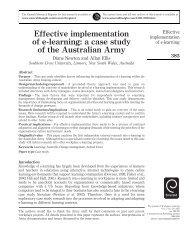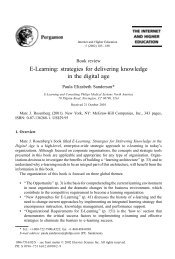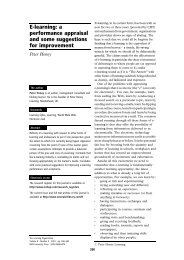Designing E-learning Interactions in the 21st Century: revisiting and ...
Designing E-learning Interactions in the 21st Century: revisiting and ...
Designing E-learning Interactions in the 21st Century: revisiting and ...
You also want an ePaper? Increase the reach of your titles
YUMPU automatically turns print PDFs into web optimized ePapers that Google loves.
Andrew Ravenscroft 139<br />
were represented by def<strong>in</strong><strong>in</strong>g `boxes', l<strong>in</strong>ked by arrows display<strong>in</strong>g mutual effects<br />
us<strong>in</strong>g ei<strong>the</strong>r a plus or m<strong>in</strong>us sign to convey direction of effect. A level <strong>in</strong>dicator on<br />
each box allowed <strong>the</strong> magnitude of <strong>the</strong> variables to be observed <strong>and</strong> altered, <strong>and</strong> a<br />
normal level Ð <strong>in</strong> <strong>the</strong> middle Ð meant <strong>the</strong>re was no effect on <strong>the</strong> connected<br />
variables. Thus, by us<strong>in</strong>g IQON, <strong>the</strong> learner could create a network of<br />
<strong>in</strong>terconnected variables <strong>and</strong> observe how chang<strong>in</strong>g <strong>the</strong> level of one variable<br />
changed o<strong>the</strong>rs, <strong>and</strong> `rippled through' <strong>the</strong> model. Experiments us<strong>in</strong>g IQON<br />
(Bliss, 1994b) to evaluate how it could facilitate or improve reason<strong>in</strong>g about a<br />
number of doma<strong>in</strong>s yielded <strong>in</strong>terest<strong>in</strong>g results.<br />
The evaluation studies showed that students had difficulty underst<strong>and</strong><strong>in</strong>g<br />
<strong>in</strong>direct effects of variable manipulations, tend<strong>in</strong>g to concentrate on l<strong>in</strong>ks between<br />
pairs <strong>and</strong> not take a more abstract view of <strong>the</strong> model as a `system'. Secondly,<br />
students paid great attention to observ<strong>in</strong>g <strong>the</strong> model function<strong>in</strong>g `on <strong>the</strong> screen'.<br />
They were described as `fasc<strong>in</strong>ated' by <strong>the</strong> activity but with `non-causal reason<strong>in</strong>g<br />
dom<strong>in</strong>at<strong>in</strong>g <strong>the</strong>ir commentaries' (Bliss, 1994b). In brief, <strong>the</strong>y had difficulties<br />
<strong>in</strong>terpret<strong>in</strong>g <strong>and</strong> underst<strong>and</strong><strong>in</strong>g <strong>the</strong> models <strong>the</strong>y had constructed. However, it was<br />
noted that predictions became more causal towards <strong>the</strong> end of <strong>the</strong> task, especially,<br />
<strong>and</strong> not surpris<strong>in</strong>gly, when students expla<strong>in</strong>ed why certa<strong>in</strong> results were obta<strong>in</strong>ed.<br />
So, it was, actually, a useful discussion tool that mediated educational dialogue.<br />
A methodological problem with <strong>the</strong>se studies was that <strong>the</strong>y did not<br />
disambiguate what occurred due to <strong>the</strong> <strong>in</strong>teraction between <strong>the</strong> learner <strong>and</strong><br />
system from <strong>the</strong> activity prompted by <strong>the</strong> researcher. Similarly, o<strong>the</strong>r studies<br />
(Hartley, 1998) have shown that, without prompt<strong>in</strong>g from a tutor, learners often<br />
show little will<strong>in</strong>gness to expla<strong>in</strong> outcomes at a conceptual, causal level. These<br />
po<strong>in</strong>ts are particularly important when we move from modell<strong>in</strong>g doma<strong>in</strong>s that are<br />
reasonably straightforward to ones that are characterised by competition between<br />
alternative conceptions (Driver, 1983) <strong>and</strong> that need to be del<strong>in</strong>eated <strong>and</strong> overcome<br />
Ð often, by address<strong>in</strong>g underp<strong>in</strong>n<strong>in</strong>g conceptions Ð to achieve a correct<br />
explanatory model.<br />
To address this problem, ano<strong>the</strong>r project <strong>in</strong>vestigat<strong>in</strong>g conceptual change <strong>in</strong><br />
science (Twigger, et al., 1991) used a qualitative modell<strong>in</strong>g language called<br />
VARILAB <strong>in</strong> concert with a simulation called DM3. The latter provided a<br />
`correct' world model of Newtonian physics, <strong>and</strong> <strong>the</strong> idea was that learners<br />
experimented with simulation scenarios that followed correct scientific pr<strong>in</strong>ciples,<br />
<strong>and</strong> hence, became familiar with, <strong>and</strong> experienced, a correct `world view'. Then,<br />
<strong>the</strong>y expressed <strong>the</strong> knowledge <strong>and</strong> underst<strong>and</strong><strong>in</strong>g that <strong>the</strong>y had acquired through<br />
modell<strong>in</strong>g <strong>the</strong> same scenarios us<strong>in</strong>g <strong>the</strong> VARILAB language.<br />
VARILAB had notions of cause-effect or agency <strong>and</strong> was loosely related to <strong>the</strong><br />
Qualitative Process Theory developed by Forbus (1984). The Objects were named<br />
<strong>and</strong> described by a set of attributes (e.g. mass, speed, colour) <strong>and</strong> <strong>the</strong>ir associated<br />
values. The causal agents brought changes to <strong>the</strong> states of objects accord<strong>in</strong>g to a<br />
`law of effect'. These object-agent connections were specified through draw<strong>in</strong>g a<br />
causal l<strong>in</strong>k <strong>and</strong> specify<strong>in</strong>g <strong>the</strong> attribute affected by a monotonically <strong>in</strong>creas<strong>in</strong>g or<br />
decreas<strong>in</strong>g relation (e.g. speed, <strong>in</strong>crease). To complete <strong>the</strong> description, a size of<br />
effect (from very small to very big) had to be <strong>in</strong>cluded. The output from execut<strong>in</strong>g<br />
<strong>the</strong> model was shown as an animated ticker-tape or <strong>in</strong> graphical form for <strong>the</strong><br />
attributes specified by <strong>the</strong> learner.<br />
ß Blackwell Publishers Ltd 2001
















